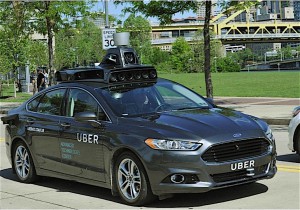
The development of autonomous vehicles is one of four trends that will dramatically reshape the industry in the next 15 years.
The auto industry is going to look dramatically different in the next 15 years than it does now, according to McKinsey & Co. Senior Partner Hans-Werner Kaas, largely due to the technological leaps that will occur between now and then.
Kaas, speaking at Autoblog’s UpShift conference in Detroit this week, said that the advancement of electric vehicles, in-car connectivity, autonomous vehicles and mobility services are the forces driving diversity and change in the industry.
Perhaps the key component to all of this “convergence” as Kaas described, is the improving range of electric vehicles. With the capability of traveling more than 200 miles on a charge becoming the benchmarks for the coming generation of EVs, it’s clear that EVs are going to become daily drivers not second cars meant to run back and forth on short errands.
Kaas isn’t the only one hyping the impact that the ongoing development of electrification, connectivity, self-driving vehicles and mobility will have on the industry. Daimler AG boss Dieter Zetsche is using those as his guideposts for his company’s product development.
Going forward, Mercedes will focus on four pillars, according to the CEO, “connected, autonomous, shared and electric.” That makes a “CASE” for a number of trends reshaping the global industry, he noted during the introduction of the Generation EQ concept.
Mercedes is forecasting that tomorrow’s cars will be connected not just to the Internet but to each other. That, in turn, will make it easier to bring autonomous and even driverless technology to market.
Car and ride-sharing are expected to become more commonplace – and Daimler has been heavily investing in both services. Meanwhile, electric propulsion is expected by many to give the conventional internal combustion engine a serious run for the money over the next decade.
(Mercedes Generation EQ concept moves battery power “into fast lane.” Click Here for the story.)
Zetsche and Daimler aren’t the only ones who share this viewpoint. A look at the recent moves by General Motors, Ford and Volkswagen support Kaas’ assertions of significant change by 2030. Aside from public acceptance of the viability of these “four horsemen” of advancement, there is a significant barrier to change: regulation.
However, even changes are in progress on that front including as recently as earlier this week as the Obama administration set a goal of zero traffic fatalities in 30 years with connectivity and autonomous vehicles being the lynchpins to success.
(Click Here for details on the Daimler/Renault-Nissan partnership.)
The administration also set forth guidelines for autonomous vehicle testing and development aimed at accelerating the timeline for getting those vehicles from the workshop to the highway.
Once technological and regulatory issues are resolved, up to 15% of new vehicles could be autonomous, he said. Use of autonomous vehicles varies drastically as Kaas claims roughly 56% of drivers would make the switch to fully-autonomous cars, Autoblog reported, while approximately 86% would make the switch if they could also still drive the vehicle.
(To see more about Rinspeed’s newest autonomous offering, the Oasis, Click Here.)
Kaas believes that mobility will be pivotal to change in the industry. As consumers determine they can be less reliant on cars, car sharing will rise to 10% of all cars being a shared vehicle by 2030. These would be used in larger cities, Kaas notes, and would likely rack up more miles than a normal vehicle, ensure automakers will still have a stable market for their offerings.
